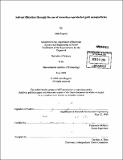| dc.contributor.advisor | Francesco Stellacci. | en_US |
| dc.contributor.author | Rogosic, John | en_US |
| dc.contributor.other | Massachusetts Institute of Technology. Dept. of Materials Science and Engineering. | en_US |
| dc.date.accessioned | 2010-09-01T16:23:18Z | |
| dc.date.available | 2010-09-01T16:23:18Z | |
| dc.date.copyright | 2008 | en_US |
| dc.date.issued | 2008 | en_US |
| dc.identifier.uri | http://hdl.handle.net/1721.1/58069 | |
| dc.description | Thesis (S.B.)--Massachusetts Institute of Technology, Dept. of Materials Science and Engineering, 2008. | en_US |
| dc.description | Cataloged from PDF version of thesis. | en_US |
| dc.description | Includes bibliographical references (p. 35). | en_US |
| dc.description.abstract | Chemical purification is typically approached by taking advantage of the constituent molecules' sizes, densities, phase transitions, or bonding capabilities to isolate individual chemical components from one another. Here, a novel approach for solvent filtration is proposed based on localized geometric constraints and bonding capabilities through the use of mixed monolayer ligand coated nanoparticles. Gold nanoparticles were synthesized and coated with octane thiol and mercaptoproprionic acid in a 3:1 ratio. Such nanoparticles have been reported to form an interesting grooved surface morphology, and it has been shown that their solubility varies according to the ability for individual solvent molecules to penetrate these grooves. Here, a system of filtration was designed, aimed at using these nanoparticles to remove a small quantity of ethanol from a solution of methanol. Solubility tests were performed on the synthesized nanoparticles and additional possible contaminants were isolated for testing including toluene, chloroform, and trihydrofuran. Titration columns were run to test the ability of the synthesized nanoparticles to separate the candidate contaminants above from a methanol solution. NMR spectroscopy of both the filtered and unfiltered solutions was performed and the results compared. Although far from conclusive, the evidence presented in this paper indicates that it very may well be possible to remove specific solute molecules from solution by flowing them through a group of nanoparticles with very clearly defined surface morphologies. | en_US |
| dc.description.statementofresponsibility | by John Rogosic. | en_US |
| dc.format.extent | 35 p. | en_US |
| dc.language.iso | eng | en_US |
| dc.publisher | Massachusetts Institute of Technology | en_US |
| dc.rights | M.I.T. theses are protected by
copyright. They may be viewed from this source for any purpose, but
reproduction or distribution in any format is prohibited without written
permission. See provided URL for inquiries about permission. | en_US |
| dc.rights.uri | http://dspace.mit.edu/handle/1721.1/7582 | en_US |
| dc.subject | Materials Science and Engineering. | en_US |
| dc.title | Solvent filtration through the use of monolayer-protected gold nanoparticles | en_US |
| dc.type | Thesis | en_US |
| dc.description.degree | S.B. | en_US |
| dc.contributor.department | Massachusetts Institute of Technology. Department of Materials Science and Engineering | |
| dc.identifier.oclc | 630057324 | en_US |
